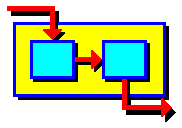A phenomena-based modeling laboratory for synthesis, modeling and analysis in chemical engineering

|
|
 |
HomeWhat is MODEL.LA?DocumentationView Animated DemoSystem RequirementsSoftware LicensingFrequently Asked QuestionsJoin Mailing List!Contact Us |
What is MODEL.LA?MODEL.LA is a computer-aided phenomena-based modeling laboratory that supports synthesis, modeling and analysis activities in chemical engineering:
To get a better feel for the features and capabilities of MODEL.LA, please view our animated demo. Why integrate MODEL.LA into the undergraduate chemical engineering curriculum?The development of MODEL.LA was motivated by an educational initiative to expand the range and complexity of problems that undergraduate chemical engineering students could tackle. As a result, MODEL.LA has been designed so that it
Who is behind MODEL.LA?The development of MODEL.LA was initiated through a collaborative effort between research groups at the Massachusetts Institute of Technology and the University of California at Berkeley. Current and past participants in the development of MODEL.LA and supporting materials include: Team Members at MIT:
Team Members at UC-Berkeley:
The developers gratefully acknowledge the National Science Foundation for support of this project. |
[ Home | Overview | Documentation | Demo | Requirements | Licensing | FAQ | Mailing List | Contact Us ]
Copyright ©2001 Massachusetts Institute of Technology. All rights reserved.
Questions or comments? Contact modella@modella.mit.edu